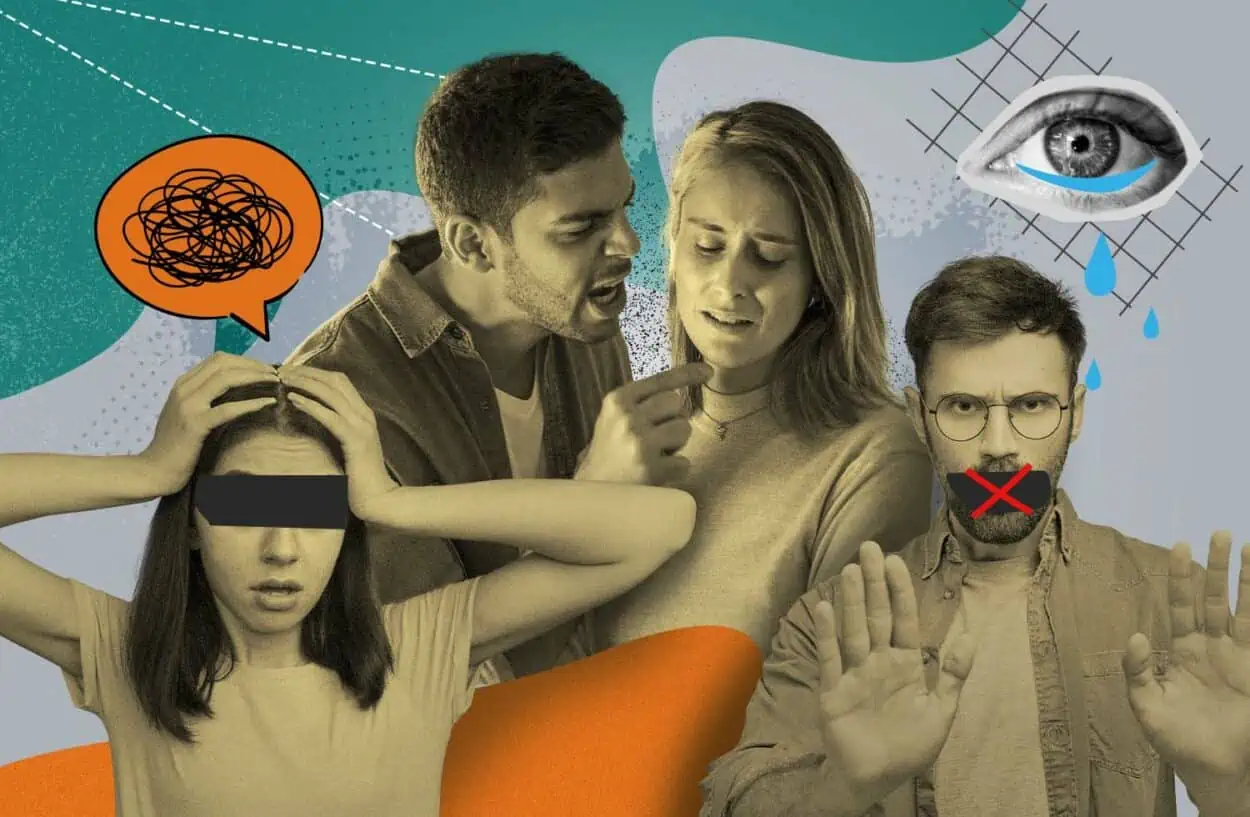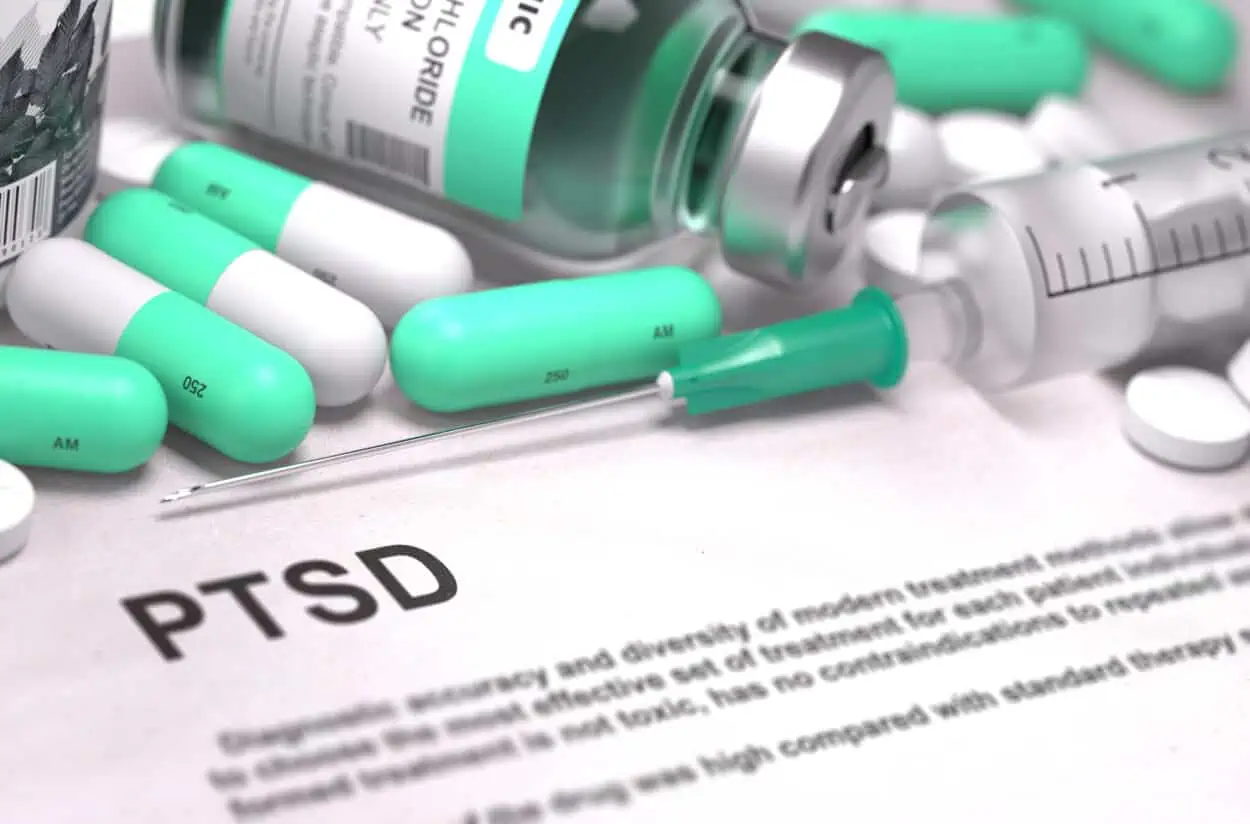
You’ve probably heard of PTSD in the context of soldiers coming back from combat zones or people who were present at huge disasters, such as 9/11 or earthquakes. You might be less aware that you can develop PTSD as a result of abusive relationships as well.
In this article, I’m going to explain how relationship PTSD differs from the PTSD you’re used to hearing about and how you know whether you might be suffering from it. I’m then going to talk you through some of the ways that you can help yourself to manage your symptoms and potentially move past that trauma.
Table of Contents
PTSD is post-traumatic stress disorder. It’s a combination of problems that all stem from an inability to process an extreme situation.1 It’s mainly categorized as an anxiety disorder because that’s the best description of many of the symptoms.
One of the most important things to remember if you suspect that you might have PTSD is that it’s actually a normal reaction to extraordinary circumstances.2 Some of the symptoms we’ll describe later are ways that your mind tried to protect you from an extreme situation but which are harmful in everyday life.
Relationship PTSD is a term used to describe PTSD that has developed as a result of being in an abusive relationship. Complex PTSD is closely related and is a response to severe trauma experienced over an extended period of time, such as abuse or a long series of assaults.
Although some researchers consider it a separate disorder, relationship PTSD has the same set of symptoms and causes as complex PTSD (cPTSD). Many professionals think that it’s more helpful to understand relationship PTSD as a form of cPTSD associated with your romantic relationships.3
One of the things that makes it so difficult to accept that you might have relationship PTSD is that you may not feel as though any of your individual events are severe enough to qualify for PTSD. That’s actually quite normal for all forms of cPTSD because the damage comes from a sustained period of powerlessness and harm, rather than a single event.
Relationship PTSD comes from having spent a period of time in an abusive or dangerous relationship. When you’re in that kind of situation, you’re often putting a huge amount of mental and emotional work into managing the situation and trying to keep yourself safe. Relationship PTSD is a reaction to that.
If you have relationship PTSD, chances are that you spent a long time in a situation that was profoundly unsafe.4 You had to learn coping strategies (such as hypervigilance) that served you well then but don’t now. You also learned things about how the world works that were true for you then but aren’t now.
Your self-esteem was damaged. You have an entirely new belief set as well as specific traumatic memories and experiences. You learned that specific things would happen to you if you did certain things. You now believe that cause and effect, even though only your ex would see those as linked.
For example, your partner might have become violent if you contradicted them. As a result, you associate disagreeing with someone (and especially someone you love) with being the victim of violence. If you try to imagine disagreeing with a partner, you might feel incredibly anxious and as if there’s a threat hanging over you. That’s your relationship PTSD.
So, what are the main symptoms of relationship PTSD? Someone with relationship PTSD can have all of the same symptoms as someone with general PTSD, as well as a few additional symptoms around social relationships and self-beliefs.5
Here are some of the signs to look out for.

When you think about PTSD, one of the first symptoms that usually comes to mind is that someone will re-experience their trauma. This is usually in the form of nightmares or flashbacks.6 Most of what you re-experience will be the worst points of your relationship.
You might also develop a “flashback chain,” where you re-experience lots of different traumatic events from your relationship one after another.
Sometimes, it will be hard to understand why a particular event has been included in your list of “worst moments.” You might find that the look on a partner’s face comes up more often than actual violence, for example.
That’s completely normal. The amount of trauma you experience from a specific event isn’t logical or quantifiable. It’s also affected by the context of when and where it happened and what it meant to you.
Flashbacks don’t have to be mostly visual. They can involve some or all of your senses. You’ll also usually experience the same emotions, and maybe even the same thoughts, as you had at the time.
You will usually be aware that you’re having a flashback, but some flashbacks can be associated with dissociations, where you aren’t aware of what’s happening.
Lots of people with cPTSD or relationship PTSD will have intrusive thoughts about what has happened to them, even long after they’re in a safe environment.7 These thoughts might be in your own voice, your abuser’s voice, or without any particular voice at all.
Intrusive thoughts are ones that you don’t want to have but struggle to move away from. It might be a phrase such as “I’m worthless” coming into your mind over and over again. It might be that you start thinking about harmful things your ex did but it feels like the thought just came out of nowhere.
PTSD is partially a disorder of memory. Traumatic experiences can be so destabilizing and emotional that our brains don’t give them the marker that lets us understand that they’re memories. As a result, memories about things associated with our PTSD tend to be really intense.
This is one of the common symptoms of general PTSD that is also present in someone with relationship PTSD.8 You might notice that you avoid thinking about the traumatic parts of your abusive relationship and that you find it difficult to talk about them.
You might feel as though your mind “skips away” from some of the worst things your ex did or said to you. You might feel too ashamed to talk to people about it, especially if your ex tried to make you feel ashamed and belittled you or told you that no one would believe you.
Use this tool to check whether he actually is who he says he is
Whether you're married or have just started seeing someone, infidelity rates are on the rise and have increased over 40% in the last 20 years, so you have all the right to be worried.
Perhaps you want to know if he's texting other women behind your back? Or whether he has active Tinder or dating profile? Or worse yet, whether he has a criminal record or is cheating on you?
This tool will do just that and pull up any hidden social media and dating profiles, photos, criminal records, and much more to hopefully help put your doubts to rest.
You might also just have a feeling that you want to put everything that happened behind you and move on completely anew. You might become frustrated when shutting your past into an emotional box is more difficult than you’d like.
Some people with relationship PTSD will avoid things associated with their trauma, but it might be slightly more complicated than it is for people with general PTSD. This might be because people with relationship PTSD have a more complicated set of feelings about their ex.
People who’ve never been in an abusive relationship can struggle to understand how you might have mixed feelings, but that’s part of what’s so insidious and damaging about abuse and relationship PTSD.
Although you know that your ex was abusive and harmed you, they probably also provided you with some love and comfort, especially at the start of your relationship. Domestic abuse victims often feel particularly torn because the person they want to go to for support and care is the very person who is hurting them.
These push/pull feelings can continue after the relationship. This might explain why people with relationship PTSD don’t always avoid things that remind them of their trauma in the same way as those who were in natural disasters, for example.
People with all forms of PTSD might find that they are easily startled and that it takes them a long time to calm down.9 You might find movies with “jump scares” intolerable after developing PTSD, or you need people around you to make a noise when they enter a room to avoid alarming you.

Hypervigilance is the term used to describe how someone with PTSD will often be constantly on the lookout for threats.10 These will often be specific to the type of trauma you experienced.
For example, someone who has PTSD after a road accident is probably going to be really aware of all the vehicles around them and alert to any signs that drivers aren’t paying attention. Someone who was assaulted in the street might notice everyone walking past them, including what they were wearing and carrying as well as their general demeanor.
Hypervigilance is mentally and emotionally exhausting. Counterintuitively, it also makes it harder for you to spot real threats. This is because everything is setting off your ‘threat radar’, which means that the real threats don’t always stand out.
If you have relationship PTSD, you might have different types of hypervigilance. You might be alert to people who might cause you physical harm, but you might also be hypervigilant about hurtful words and comments. This might look to others as though you always assume the worst interpretation of what someone has said.
As I’ve already mentioned, PTSD is an anxiety disorder. Having relationship PTSD will often mean that you spend a lot of your time feeling very anxious, stressed, and afraid. It can also mean that you get angry very easily and you have difficulty moderating your emotional reactions.11
If you have relationship PTSD, dealing with your own anger can be incredibly challenging. You might not have been able to communicate your anger safely in your abusive relationship, so you’re used to just pushing it away and being afraid of it.
You might also associate anger with your abusive ex, leaving you feeling ashamed of your own angry thoughts or feelings.
With all of these strong feelings, intrusive thoughts, strong memories, and hypervigilance, it’s probably not surprising that people with PTSD can have difficulty concentrating.
You might find your attention wandering during conversations or when you try to work for a long period. This can be something else that triggers your anger and irritability, as you become frustrated at yourself for not being able to focus.
PTSD can also lead to an unusual symptom known as dissociation.12 If you haven’t experienced it, it can be difficult to imagine.
Dissociation is when you stop feeling as though your mind and body are really connected, or you feel untethered from reality. You might start to feel as if the things that you’re seeing and hearing are coming from far away. In extreme cases, you might develop gaps in your memory for the time that you’re dissociating.
It probably won’t surprise anyone to know that people with relationship PTSD will often struggle to learn to trust others again. Although lots of people with PTSD struggle with issues of trust, those with relationship PTSD and those who were abused as children share a unique challenge.
Someone with relationship PTSD or who was abused as a child was hurt and damaged by one of the people they should be able to trust most in the world. In the case of relationship PTSD, you chose that person and you thought that they were worthy of that trust.
Having been betrayed by someone who should have been your biggest supporter and protector has a profound impact on your ability to trust. You might start looking for signs that someone is about to harm you (even when they’ve given no sign of this) or you might struggle to relax and feel safe with them.
This can move you toward a disorganized or avoidant attachment style. You don’t want to rely on others again because, deep down, you don’t believe that they’re going to be there for you. This can leave you feeling closed off and isolated.
People with relationship PTSD will also often engage in behavior that seems self-destructive and even counter-intuitive. For example, you might date another partner who reminds you of your abusive partner, often leaving you experiencing abuse all over again.
PTSD is also associated with higher rates of alcoholism and substance abuse.13 There are different reasons for this drive toward self-destructive behavior. Often, it can be due to a lack of self-esteem and believing that you don’t deserve a healthy relationship.
Alcohol and drugs can also provide a short-term numbing, which can make the symptoms of PTSD temporarily more manageable. People with relationship PTSD may not understand why they’re driven to these kinds of self-destructive behaviors, and this can create a cycle of shame and self-harm.
PTSD is a real medical condition and it is treatable. Some people are able to deal with their symptoms sufficiently that they consider themselves cured, whilst others know that they still have the condition but are able to manage it effectively.
The important thing is to reach out and get the treatment that you need. Struggling through relationship PTSD alone is rarely effective. The sooner you can seek help, the sooner you’re able to find a place of hope and optimism.
Here are some of the things you might want to investigate to help you overcome your relationship PTSD.

In recent years, several different medications have been licensed to help treat PTSD. These play different roles, depending on your precise symptoms. You might be offered medication to help you sleep, antidepressants to help you deal with low mood, or anti-anxiety medication to make it easier for you to deal with stressful situations.
It’s important not to under- or over-emphasize the importance of this medication. It’s incredibly helpful in allowing many people to function well in their everyday lives. They’re not addressing the root cause of the problem, however.
One powerful role of these medications is to give you the energy and emotional resources you need to be able to engage with therapy and process your trauma.14
Therapy is another important aspect of coping with your relationship PTSD. There are many different types of therapy available to you and even if one is unsuccessful, there will be more that you can try.
CBT is one of the first treatment options most people with PTSD will be offered. It has success rates of around 40/50%, although this does vary.15 Many of the other treatment options are based on similar principles, such as EMDR (eye-movement desensitization and reprocessing) and exposure therapy.
This can be highly effective for many people, but they’re not the only way to deal with relationship PTSD. Longer-term therapies, such as psychodynamic or person-centered, offer you the opportunity to explore all of your thoughts, feelings, and reactions around your trauma in a safe and supportive environment.
Studies show that the most important ingredient in successful therapy (even more so than the type of therapy used) is the relationship you build with your therapist.16 Keep looking until you find someone you feel comfortable with and can trust.
Having a strong support network can be invaluable to someone struggling with relationship PTSD. Reaching out to people you trust helps you rebuild your faith that there are good and loving people in the world.
Support groups can be especially helpful. Talking with other people with relationship PTSD allows you to understand that your feelings are normal and can help you to see that you weren’t to blame for what happened to you.
Self-care is almost never enough to overcome relationship PTSD on its own. All forms of PTSD are serious and need help and support to work through.
That doesn’t mean that self-care isn’t important. It does provide essential support and assistance when you’re working through your issues. Self-care is a way of showing yourself love and helping make sure that you have the resources you need to work through your trauma.
The vast majority of breakups are upsetting, but not traumatic. Relationship PTSD doesn’t come from the breakup of a relationship. Instead, it’s the months or years of abuse during the relationship that do the damage. Relationship PTSD is a response to an abusive relationship, not just one that ended badly.
A bad breakup or an abusive relationship can damage your self-confidence and self-esteem. It can make you more timid, nervous, and anxious, and make you look for more reassurance. In most cases, this is temporary but long-term abuse will usually have more long-lasting changes.
Relationship PTSD is a completely valid form of PTSD, although it usually comes under the umbrella term of cPTSD. Knowing that someone we love is willing to cause us so much harm can deeply undermine our sense of self-worth and our ability to relate to others in the future.
Relationship PTSD is difficult to recognize because we associate PTSD with one-off trauma such as a natural disaster. Long-term abuse often doesn’t have a single, defining event that we can point to. We’re also used to blaming ourselves and doubting our own reactions.
Having relationship PTSD doesn’t mean that you’re damaged or broken. It means that someone has treated you very badly and you will need help getting over that. Reaching out for the support you need can help you find your way back to healthy relationships in the future.
Was this article helpful? Let me know your experiences in the comments and don’t forget to pass this article on to someone who needs hope and support in overcoming relationship PTSD.
Utilize this tool to verify if he's truly who he claims to be
Whether you're married or just started dating someone, infidelity rates have risen by over 40% in the past 20 years, so your concerns are justified.
Do you want to find out if he's texting other women behind your back? Or if he has an active Tinder or dating profile? Or even worse, if he has a criminal record or is cheating on you?
This tool can help by uncovering hidden social media and dating profiles, photos, criminal records, and much more, potentially putting your doubts to rest.
